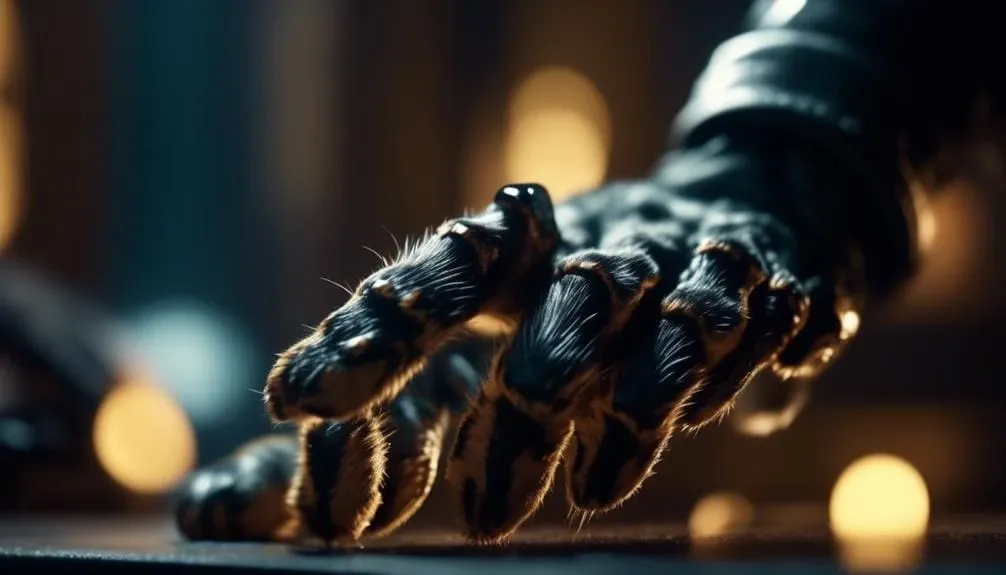The Best Fluffy Pancakes recipe you will fall in love with. Full of tips and tricks to help you make the best pancakes.

Hand-biting behavior in cats has long perplexed owners, who often find themselves at a loss when it comes to understanding the motivations behind this puzzling behavior.
As we delve into the complex world of feline hunting instinct, we begin to unravel the mystery of hand-biting.
From their innate predatory nature to the various triggers that can lead to aggression, there is much to explore in our quest for knowledge.
Join us as we uncover the underlying causes and seek effective solutions to manage hand-biting behavior in our feline companions.
Key Takeaways
- Cats bite and grab hands due to their natural hunting instinct, not to intentionally hurt their owners.
- Accidental hurt, such as stepping on their tail, can trigger hand-biting behavior in cats.
- Redirecting their behavior to toys or scratching posts can help prevent hand-biting during play.
- Cats may exhibit hand-biting behavior as a result of redirected aggression, which can be reduced by identifying and addressing the source of stress.
Hunting Instinct: Cats' Natural Behavior
Cats' hand-biting behavior can be attributed to their inherent hunting instinct, a natural behavior deeply rooted in their predatory nature. Understanding hunting behavior is crucial in comprehending why cats engage in this behavior.
Cats, as obligate carnivores, are born with an innate drive to hunt and capture prey. This instinctive behavior is characterized by stalking, pouncing, and biting. When cats bite and grab your hand, they are mimicking their hunting techniques, treating your hand as a toy mouse.
It is important to note that cats are not intentionally trying to hurt you, but rather acting out their natural predatory instincts. To address this behavior, it is recommended to gently back away and try to soothe and calm them instead of punishing them.
Accidental Hurt: Understanding the Triggers
Understanding the triggers behind cats' hand-biting behavior due to accidental hurt is crucial in addressing and preventing this behavior. Cats, like any other animals, experience pain and discomfort. It is important to recognize and understand the feline pain triggers that may lead to hand-biting.
Accidental hurt, such as stepping on a cat's tail or handling them in a way they find uncomfortable, can trigger fear or pain, causing them to bite or grab your hand. To prevent further aggression, it is essential to build trust after accidental hurt. Reacting calmly, avoiding sudden movements, and providing a calm and secure environment can help alleviate their stress and reduce the likelihood of hand-biting.
Playful Behavior: Channeling Their Energy
After addressing the triggers behind cats' hand-biting behavior due to accidental hurt, it is important to shift our focus towards understanding and managing their playful behavior by channeling their energy.
Cats often bite and grab hands as part of their natural hunting behavior during play. To redirect their behavior, it is crucial to provide them with appropriate playtime strategies that engage their playful side. Interactive toys can play a significant role in keeping cats entertained and stimulated. Feathered balls, toys with bells, and tactile toys for scratching are excellent options to engage their hunting instincts.
Redirected Aggression: Identifying the Source
To effectively address and manage cats' hand-biting behavior caused by redirected aggression, it is crucial to identify the underlying source of their stress or perceived threat. This can be achieved by observing and identifying signs that may indicate the presence of redirected aggression.
Some signs to look out for include sudden changes in behavior, increased vocalization, dilated pupils, and aggressive body postures. It is important to note that these signs may vary depending on the individual cat.
Once the signs have been identified, it is advisable to seek professional help from a veterinarian or animal behaviorist who can provide guidance and develop a tailored plan to address the underlying cause of redirected aggression. Seeking professional help is essential for a comprehensive assessment and to ensure the well-being of both the cat and their human companions.
Burst of Energy: Managing Their Wild Side
Having identified the underlying source of redirected aggression, it is imperative to address the issue of cats' hand-biting behavior by effectively managing their burst of energy and wild side.
Cats are naturally wild and energetic animals, and this energy needs to be channeled appropriately to prevent hand-biting incidents. Increasing engaging playtime and providing outlets for their energy is key. Interactive play with toys and encouraging exercise can help cats release their excess energy in a controlled manner.
Providing a variety of toys, such as feathered balls, toys with bells, and tactile toys for scratching, can keep them entertained and engaged. By offering these outlets, cats are less likely to resort to hand-biting behavior, leading to a safer and more harmonious environment for both cats and their owners.
Conclusion
In conclusion, understanding the underlying reasons behind hand-biting behavior in cats is crucial in maintaining a harmonious relationship between humans and their feline companions.
By recognizing and addressing factors such as a cat's innate hunting instinct, fear, pain, accidental hurt, playful behavior, redirected aggression, and bursts of energy, owners can effectively manage and minimize hand-biting incidents.
Through providing appropriate toys, a stimulating environment, increased playtime, and interactive play, owners can channel their cats' energy and promote a safe and peaceful environment for both humans and cats alike.








